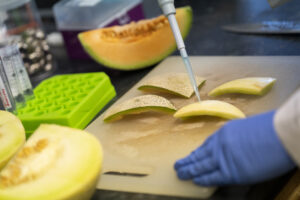Table-to-farm approach will create healthier U.S. melon supply chain
Texas A&M AgriLife researchers are changing how melon cultivars are improved
Texas A&M AgriLife Research scientists at the Vegetable and Fruit Improvement Center in College Station are using a “table-to-farm” approach to create a safer, healthier and more sustainable melon supply chain in the U.S. by considering consumer preference at the dinner table.

Leading the team is Bhimu Patil, Ph.D., Texas A&M College of Agriculture and Life Sciences Department of Food Science and Technology interim department head and Regents Professor, Bryan-College Station. Patil’s team is using a multi-pronged approach to improve breeding, bolster the consumption of regionally produced specialty melons and strengthen the competitiveness and sustainability of the U.S. melon industry.
The research has been supported since 2017 by a $4.4 million grant by the U.S. Department of Agriculture’s, USDA, National Institute of Food and Agriculture. USDA-NIFA has also designated the Vegetable and Fruit Improvement Center as a National Center of Excellence on Melons.
Consumer first
The center has conducted extensive studies and surveys showing that looks, taste and nutritional value are the three main factors consumers consider when purchasing melons. So, the team is focusing its melon breeding efforts toward satisfying consumer demand. Specifically, the team seeks to develop new melon cultivars with enhanced nutrition and flavor.
“Starting with consumers should also help producers. If the new melon varieties lead to increased consumption and demand by consumers, financial returns should increase for retailers and producers,” Patil said.
The team is also working to develop region- and cultivar-specific agronomic practices and technologies to improve the melons’ environmental stress resistance, production efficiency and food safety attributes. For example, the researchers aim to identify crucial control points and develop pre- and post-harvest strategies to minimize microbial contamination.
Producers believe the approach is the right direction.
“Table-to-farm is a great approach on determining what our industry needs to do to improve consumption of fresh fruits and vegetables,” said Little Bear Produce president Jimmy Bassetti.
He said the industry is also keenly aware that while appearance and flavor remain the top factors in produce preferences, nutritional value is quickly gaining ground as a top purchase motivator.
“We look forward to new varieties that can achieve the ideal attributes of looks, taste and nutrition to enhance profits for retailers, food service and producers,” Bassetti said.
Better tasting melons

Melons come in a wide range of flavors, and each fruit’s flavor is due to a signature assortment of volatile organic compounds, or VOCs. To understand how VOC profiles develop, the researchers performed metabolomic and transcriptomic analysis of two cantaloupe varieties over the course of fruit development.
“We try to obtain chemical signatures for fruit maturity, fruit health and levels of enzymes. We can then identify changes in signatures from various cultivars and geographic locations that will, when combined with metabolite profile analysis, indicate the key components of making great aromatic flavors in melon fruits,” said Hisashi Koiwa, Ph.D., Texas A&M Department of Horticultural Sciences professor.
The research helped identify shifts in VOCs that coincide with the expression of specific factors like fruit ripening. The results are key in helping researchers create new cultivars that live up to consumer taste and nutritional value expectations.
Identifying optimal growing locations
Cantaloupe is a good dietary source of amino acids, but amino acid levels can vary depending on where the fruit are grown. Understanding why this occurs is important for producing new cultivars that meet increasingly high standards for consistency and quality control.
To examine the variations among growth environments, the researchers looked at cantaloupes grown in Texas, Georgia, North Carolina, California, Indiana and Arizona. The results from this study showed significant differences in amino acid levels, VOCs and antioxidant activity in cantaloupe varieties based on location. Their results underscore the importance of growing location in the selection and improvement of certain melon varieties. Research findings are published in the journal Plants.
A more sustainable supply chain
By implementing the “table-to-farm” approach and existing research on melon taste and growing locations, researchers expect to create new and unique cultivars that are well-suited for regional production and distribution, and which meet the needs of the consumer with high standards of food-safety. In return, the team anticipates increased consumer loyalty and repeat purchasing, which will benefit producers, processors and distributors nationwide.
“New generation consumers are trending towards flavorful, healthy and tasty food; therefore, producers must act on such demand,” Patil said.
The following collaborators from Texas A&M contributed to the study: Kevin Crosby, Ph.D.; Hisashi Koiwa, Ph.D.; John Jifon, Ph.D.; Ronda Miller, Ph.D.; Fred Nafukho, Ph.D.; Daniel Leskovar, Ph.D.; Stanislav Vitha, Ph.D.; Xiaoning Qian, Ph.D.; and Marco Palma, Ph.D. Members from partner institutions include: Sadhana Ravishankar, Ph.D., University of Arizona; Paul Brierley, Ph.D., University of Arizona; Kerry Cooper, Ph.D., University of Arizona; Tom Turini, University of California; Andre Luiz Biscaia Ribeiro da Silva, Ph.D., University of Georgia; Wenjing Guan, Ph.D., Southwest Purdue Agricultural Center; and Jonathan Schultheis, Ph.D., North Carolina State University.


